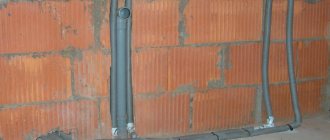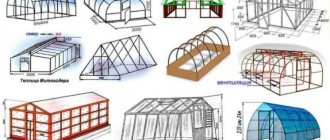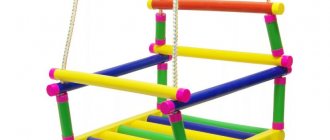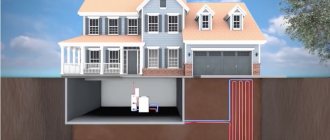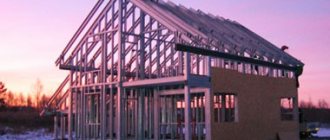To make greenhouses on your own site with your own hands, you use various materials, from wood to metal. The craftsmen also paid attention to such material as PVC.
Do-it-yourself greenhouses made from PVC pipes can be found quite often. This is due primarily to the relative cheapness of the material, good workability, lightness and sufficient elasticity.
Advantages and disadvantages of plastic construction
On the left is a pitched greenhouse, on the right is an arched greenhouse made of plastic pipes
In terms of popularity, greenhouses made of plastic pipes have long surpassed similar structures made of wood and metal. This is largely due to the high performance of the pipes, their availability and durability.
Among the advantages of such greenhouses are the following:
- Easy to assemble - the plastic pipe bends relatively easily, which allows you to form a frame of the desired size. You do not need to have any special skills or use a special tool.
- Light weight - if necessary, the greenhouse can be easily transported from place to place without disassembly. And also the frame can be easily disassembled and reassembled, which allows you to dismantle the greenhouse during the cold season.
Sloped greenhouse for vegetables made of plastic pipes
- Wear resistance - PVC pipe does not require additional treatment with an antiseptic and anti-corrosion compound. The plastic used for the production of pipes is not afraid of temperature changes, moisture, or open fire.
- Cost - the total cost of a plastic frame structure is cheaper than frames made of wooden slats and a metal corner. Over time, the plastic frame does not need to be repaired - the damaged pipe can be easily replaced with a new product.
Greenhouses made from PVC pipes are aesthetically pleasing and easily fit into the landscape design of a summer cottage or suburban area. The main disadvantage of plastic structures is their general instability in strong gusty winds.
The greenhouse can swing violently and come off the ground, which can damage the frame. But this problem is easily solved by installing special supports in the corners or perimeter of the base.
IV. Arched greenhouse made of pipes and polycarbonate
Instead of film, cellular polycarbonate can be attached to an arched frame built according to the principle described in option No. 1, instead of conventional film. When the entire frame and pipes are installed and secured at the joints, you can begin installing the polycarbonate. Read about the rules for working with polycarbonate sheets in our other materials.
Sheets of plastic should be attached to arches and ends using special thermal washers or roofing screws. Polycarbonate cells should be positioned vertically.
And more master classes to help beginning greenhouse growers:
Preparing to build a greenhouse with your own hands
Before you begin making a greenhouse from PVC pipes, you will need to make a design drawing, select and calculate the amount of material required, and also prepare a place for installing the frame.
Pipe greenhouse project
Schematic design of a greenhouse made of polypropylene pipes
If you are a builder or have some experience in construction, then you can make the project and drawing of the future greenhouse yourself. In other cases, we recommend using ready-made solutions and performing the necessary calculations based on them.
Drawings of greenhouses made from pipes can be found on the Internet or in printed publications dedicated to gardening. For example, ready-made projects are often found in magazines where, as advertising, they talk in detail about various models of greenhouses from the manufacturer. Usually, journalists describe in detail the advantages of the frame and attach a diagram of its assembly.
Above is a similar diagram of an arched greenhouse made of PVC pipe. Based on it, we will calculate the materials that will be required to construct the structure, and also consider the process of its assembly.
Calculation of the required material
One of the options for an arched greenhouse made of PVC pipes
The diagram above shows a standard arched greenhouse with a length of 6 m, a width of 3 m and a height of 2 m. This length and width provide sufficient space for plants to grow, and the height makes it possible to move freely around the greenhouse. If necessary, the length can be increased.
To assemble the greenhouse you will need:
- The pipe is polypropylene marked PN 10 with a diameter of 25–32 mm and a total length of 70 m.
- Board for the box - to assemble the base you will need a board 25*200*6000 mm in the amount of 3 pieces.
- Board for planks - to make ridge and longitudinal strips, you need a planed board 20x90x6000 mm in the amount of 5 pcs.
- Board for gables - to make a door and strengthen the gable, you will need a planed board 20x70x3000 mm in the amount of 12 pcs.
- Cross fitting - selected strictly according to the diameter of the pipe in the amount of 28 pieces. In our case, a PVC cross with a diameter of 25.2 or 32.2 mm is required.
Two types of fittings for assembling a greenhouse from plastic pipes
- Tee fitting - similar to a cross, it is selected for the cross-section of the pipe. Total quantity - 10 pcs.
- Galvanized self-tapping screws - with a press washer, a semicircular or straight head 40 mm long.
- Polyethylene film - reinforced for greenhouses with a thickness of 200 microns, a width of 6 m and a total area of 40 m2.
- Hinges - when installing doors, you will need 6 stainless steel hinges. To install the window - 2 pcs.
The described version shows a project for a greenhouse from which the covering will be removed for the winter. If you do not plan to remove the film, then the step between the arches should be reduced to 0.5–0.7 m. This will allow you not to worry that the structure will deform under the weight of the snow. In this case, the amount of pipe required increases to 90 m.
Tips for choosing material
Polypropylene pipe is well suited for constructing a strong and durable frame for a greenhouse
Plastic pipes come in several varieties. To make greenhouses, it is better to use polypropylene, polyvinyl chloride (PVC) or metal-plastic pipes. All of the above types of pipes are resistant to low and high temperatures, moisture and mechanical damage.
The polypropylene pipe bends poorly and has thick walls, but with sufficient force it is not difficult to bend the arch. Metal-plastic and PVC pipes are made of softer plastic - the wall thickness is no more than 1.5 mm, which guarantees higher ductility. The pipe bends easily with bare hands. When using softer pipes, it is recommended to reduce the pitch between the arches.
It is better to choose larch products as boards. Pine and spruce wood does not withstand constant exposure to moisture so well, and after 2-3 seasons the planks may need to be replaced. The same applies to base boards. If possible, it is recommended to use an antiseptic impregnation.
Necessary tool
When using a PVC pipe, it is recommended to reduce the pitch between the arches
To make an arched greenhouse you will need the following tool:
- hammer and mallet;
- hacksaw for metal;
- wood hacksaw;
- screwdriver or Phillips screwdriver;
- bubble level;
- construction knife;
- tape measure 7 m long.
I. Functional growlab for seedlings
Growlab is a great option for growing plants in containers. Using PVC pipes, you can build a spacious greenhouse for seedlings or growing crops with a small root system in separate pots. Such a greenhouse will be insulated not only by walls, but also by agrofilm from the ground. This allows you to create a real laboratory for growing plants on the site, a certain microclimate and temperature regime.
First, we choose a place and prepare the base for the greenhouse. We mark the perimeter and fence it with a wooden box. The walls of the box are knocked together using long anchors and reinforced with metal corners at the junctions with each other. An important nuance is to level the base. If the area is sloped, blocks, bricks or other available materials should be placed under the walls of the box.
Inside the walls of the box it is necessary to place base pipes for PVC arches or make holes for PVC pipes in the ribs of the wooden base in advance. The box can also be laid on a ready-made foundation for a greenhouse. Dense agrofibre is laid on top along the entire perimeter of the greenhouse - a soft floor for our growlab, which will protect the greenhouse from weeds and help maintain the desired climate regime inside the greenhouse.
And one more important point: do not hammer the base pipes into the ground with a “naked” hammer. Plastic can easily crack from such exposure. Place a piece of wood block or board over the pipe and then drive the pipe into the ground using wood.
Now you need to correctly install the PVC frame. You can choose a gable structure or build an arched greenhouse. For the first option, it is better to choose rigid PVC pipes. We will tell you how to bend arches correctly a little later.
Installation of arches must begin with the end arch. Both edges of it are inserted into the pipes. If the arches fit too loosely, then the material needs to be compacted. To do this, you can drive wooden pegs along with the pipe or wrap the edges of the arches with sealing material
To strengthen the PVC frame, it is better to use longitudinal strips. The central pipe is fixed on the outside of the arches. The inside of the frame also needs to be reinforced with planks. PVC pipes are connected using long bolts, holes for which are made in advance
The arcs are inserted into grooves made of pipes, which we dug into the ground level. If the edges of the arches do not fit tightly into the grooves, you can strengthen them with wooden strips inserted into the pipes along with the arches. For greater reliability, they can be reinforced with bolts. When all the arches are in place, the frame should be reinforced from above with longitudinal pipes. The central pipe is placed on the outside of the greenhouse skeleton, and the two side strips are mounted on the inside. The pipe connections are tightened with bolts and nuts so that the frame is collapsible.
A wooden plank with a holder profile for covering material can be attached to PVC pipes at a distance of about 50 cm from the ground. This will make it possible to ventilate the greenhouse from below
The contact of PVC pipes and the covering sheet gives rise to a certain thermal, chemical and mechanical interaction of these two materials. To avoid premature wear of the greenhouse, the outer surface of the pipes (points of contact with the film) should be insulated with protective adhesive tape. This way your greenhouse will last as long as possible.
The hole for the arc on the outer end strips is made at a bevel. It is necessary to accurately measure the angle of inclination of the arc, draw it on the edges of the bars and mark the place of the cut. The pipe must lie tightly on the stand so that the structure does not lose stability
The end walls are best made of wood. In addition to the doorway pillars, it is necessary to make two more supports in the corners of the ends. The bottom of the end walls can be covered with plywood or plastic. Now you can stretch the film over the walls and ends of the greenhouse and begin preparing the plants for growing.
And another master class on building a greenhouse using the same technology:
Related video: greenhouse made of PVC pipes
Plastic pipes are suitable for the manufacture of greenhouses of any size and type, and a large selection of fittings simplifies the assembly process. On average, a greenhouse made of PVC pipes costs 2–3 times less than its counterparts made of metal or wood, which makes it possible to install several structures on the site at once.
- Author: Vitaly Varlamov
Hello. My name is Vitaliy. Area of professional activity: technical means of automation and design technologies. Rate this article:
- 5
- 4
- 3
- 2
- 1
(7 votes, average: 3 out of 5)
Share with your friends!
III. Collapsible mini-greenhouse
Using PVC pipes, like a construction set, you can create a small greenhouse for growing herbs and vegetables in early spring. To implement this idea, you will need the actual PVC pipes, connecting elements for them, a meter, a jigsaw for metal and any covering material. This design does not need to be made bulky. Its height will be up to 1 m, as well as its width. You can choose the length at your discretion.
The work will consist of cutting pipes of the required size and connecting them together with tees and PVC crosses. The vertical posts must be secured with a transverse strapping, from which the gable roof pipes will also be led to the ridge top pipe. It is not necessary to attach the structure to the base. You can cover it with film and use it as a cover for a high bed.
What designs are most popular among summer residents?
Among all types, arched, single-slope and gable ones are considered priority. They require minimal effort during installation and are reliable in use for several seasons. If you have definitely decided for yourself that you are ready to build the structure yourself, these 3 options will be the best choice for any site.
Let's look at the features of each of the greenhouses.
Arched greenhouses
The cheapest and most practical option. The roof structure is made in the form of an arch, due to which maximum light transmission is achieved. The sun's rays, falling on the arched surface of the roof, are easily dispersed over the entire area, which provides maximum heat and light for the planted plants.
In addition, the arched shape of the roof does not allow snow to accumulate on the top, deforming the structure.
Lean greenhouses
This type is usually attached to one of the walls of a house or other country building. The connection to the wall makes it much easier to install and fix the entire structure. Usually the location is chosen to be south facing to ensure maximum lighting.
If there is a suitable building on the site for installing a lean-to greenhouse, you should opt for this option. An additional advantage here will be the fact that heating costs can be reduced, because... the structure is already adjacent to the heated room.
Gable greenhouses
The shape of the roof resembles a triangle. Such structures are found in almost every dacha. The choice in favor of a gable greenhouse is due to the fact that its size exceeds the two previous options, which makes it possible to grow various types of crops in greenhouse conditions. Useful space can also be used to create a recreation area.
For each of the listed types, you can choose wood or PVC pipes as the main material for the frame. The latter are cheaper, and such material is easier to construct for people with minimal skills.
The coating is usually glass, polyethylene film or polycarbonate.
Nuances, the knowledge of which will be useful for novice masters
I. How to easily make PVC arches
And now, the promised advice: how to bend a PVC pipe easily and evenly. To do this, you need to know the exact width of your future greenhouse. For example, for a greenhouse width of 2.5 meters, you need to prepare a wooden beam 250 cm long and a PVC pipe 600 cm long. With these dimensions, the height of the greenhouse will be about 2 m. We lay the beam on a flat surface, and limit its edges with padded strips. We have a blank for bending an arc.
We apply the pipe to the inside of the transverse limiter bar with either end. It is better to secure it with a temporary bolt or self-tapping screw. We slowly bring the other end to the opposite edge of the board and place it under the second stop. We check that the center of the curved pipe is in line with the middle of the wooden beam. Using the same pattern, we bend the remaining arcs for the greenhouse.
II. An interesting option for attaching film to a PVC frame
We would like to tell you about a new method of attaching covering material to the greenhouse frame without seams or puncturing the fabric. To do this, at the very bottom (as close as possible to the ground) on the PVC pipe you need to fasten a longitudinal wooden strip. It is better to use bolts for fastening. A longitudinal groove must be attached to this wooden plank in advance. For such a groove, you can take an ordinary plastic plinth with an internal compartment for an electrical wire, or any other prefabricated device. We attach the plinth to the plank with self-tapping screws, having first removed the inner insert. We cover the top of the greenhouse with film so that its edges go beyond the strip with the plinth. We insert the material into the hole for the wire and close it with a plug on top. A reliable removable mount is ready! This device is very convenient to use. The film can be removed or tightened if the tension weakens.
III. Options for attaching plastic pipes to the base
- The fittings are a convenient base for PVC pipes. The rods go deep into the ground or are inserted into the ground to 2/3 of the depth. The pipes are placed on the rods, and the structure is kept level and stable. The simplest option for small greenhouses is to deepen the pipes directly into the soil;
- Pipes can be installed in pits with crushed stone and cement. This design will be stationary and cannot be disassembled for the winter;
- If a concrete foundation is poured for the greenhouse or a brick base is built, then holes need to be made in it for PVC rods. The ends of the pipe must be wrapped in insulating material and inserted into the prepared holes until they stop;
- PVC can also be easily fixed to a wooden base. You need to make holes in the edges of the box into which metal rods are inserted. The reinforcement is driven into the ground so that 2/3 of its length is on the surface. Pipes are put on the rods;
- PVC pipes can be installed in larger diameter water pipes. It is better if the arches fit tightly into the base. To do this, it is worth selecting pipes with a slightly larger diameter than the frame pipes.
IV. Features of PVC frame connection
For the greenhouse, standard PVC pipes with a diameter of 20-32 mm are used. To connect them, you can use glue, tightening clamps, furniture bolts and fittings (crosses, tees and corners). If you choose a connection using bolts, then the holes in the pipes must be drilled in advance.
Materials
Based on the greenhouse design, make an estimate for the required materials. A detailed display of all details and dimensions on the sketch will allow you to easily make calculations. Main items of purchased material:
- PVC or metal-plastic pipe. Calculate how many pipe products you need to build a frame, install doors, windows;
- polycarbonate The minimum thickness for a greenhouse structure for covering material must be at least 15 mm;
- wooden block or metal material for installing the foundation;
- rope;
- poles or pegs;
- latches, locks, clamps, door fittings;
- fasteners - metal screws, special fastenings for pipes, staples, nails.
Depending on the design solution, take into account the stiffening ribs, the number of doors and windows for ventilation.
Polycarbonate greenhouse at homeGrowing vegetables, flowers and herbs on your own plot allows you to get an environmentally friendly harvest. Greenhouses from…
How to seal a structure
The tightness of the structure is necessary to create a favorable climate inside the structure. Install a polycarbonate greenhouse on plastic pipes in compliance with the following nuances:
- dig the base with soil and cover it with additional hay;
- cover the joints between the sheets of covering material with special tape;
- Fill connections in corners and ends with sealant;
- ensure a tight fit of the greenhouse box to the foundation, glue a tape from the bottom that goes onto the grillage;
- When making doors and windows, adjust the size of the polycarbonate so that it fits the walls of the structure.
Sealed protection of a greenhouse structure made of polycarbonate from the inside and outside will ensure heat retention inside by 35% longer. A securely wired design will allow you to grow crops from early spring to late autumn, and in the southern regions all year round.
Assembly steps
After purchasing the required amount of building materials and creating a project, carry out the construction process according to the following algorithm:
- select a location for the greenhouse structure. Choose flat areas that are well lit by the sun;
- level the site for installation of the structure - remove plantings, ridges, dismantle buildings, if necessary, backfill with soil or sand;
- mark the area using rope and poles;
- install a foundation crown, if provided for by the project;
- assemble a frame from pipe blanks in accordance with the planned shape of the structure;
- cut the polycarbonate according to size;
- sew the frame with polycarbonate fabric;
- make doors and windows from rolled plastic pipes and polycarbonate.
Start work in the morning. It is better to do construction in sunny weather. In just one day you can build a greenhouse structure to grow your own crops.
Methods for connecting frame and covering
The polycarbonate sheet is attached to the assembled frame in different ways, which depend on the shape of the greenhouse. The covering material is sewn up:
- joint to joint. Polycarbonate, adjusted to each other, is applied to the frame and secured with hardware. The joint gaps must be additionally closed in the future to prevent heat leakage from the structure;
- overlap The method is suitable for sewing large pieces with a thickness of 1.5 cm or more. Overlapping areas require additional coating for tightness.
Important! In winter, shake off snow from slopes or arches so that large amounts of precipitation do not accumulate on the surface, increasing the load on the frame.
To install the covering material to the frame, choose hardware with wide heads. Additionally, place a polymer washer between the fastener and the surface.
Homemade gable greenhouse from a profile pipe. A greenhouse with a gable roof is not uncommon on personal plots. Make it on a frame from a profile pipe with your own...
What you need to know before starting work
Before deciding to build a greenhouse, you need to consider several general points:
- dimensions and area of the site;
- choosing a place to place the greenhouse on the site (where most of the sun's rays fall);
- the size and area of the future “home for plants”;
- types of crops that are planned to be grown;
- Will additional technologies be used in the greenhouse (automatic watering, lighting).
The most favorable location of the greenhouse is from south to north with a deviation of 15-20 degrees to the west and east
If you decide to build a small greenhouse with a plastic frame, keep in mind that plastic pipes are easy to cut, bend, glue and connect together. For summer cottages, one of two types of polymer pipes is usually used:
- rigid polyvinyl chloride pipes - they are used for the construction of straight and strict structures: single- and double-slope greenhouses in the form of “houses”;
- flexible PVC and polypropylene pipes - these materials are used to make arched, spherical and hemispherical structures or superstructures over a rigid base of wooden or metal slats.
Whatever type of pipes you choose, they will all be equipped with fittings - connecting elements in the form of cross or tee splitters, adapters and rotary connectors.
You should also decide on the type of greenhouse construction - will it be collapsible or stationary. In the first case, the elements are fastened together using fittings and screws, and in the second, they are glued or welded “forever.”
Tools
To assemble the greenhouse you will need the following list of tools and accessories:
- construction tape;
- level;
- hacksaw for metal;
- Bulgarian;
- hammer;
- screwdriver
Important! Pay attention to safety precautions. Work in overalls, safety glasses, gloves, and durable shoes.
Make sure that there are no pets or children in the area where the greenhouse structure is being assembled. When working with the release of heat and sparks, carry out the processes away from dry grass.

